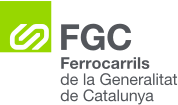[reciver_info_ecocalculadora]
FGC ECOCALCULATOR
Join the sustainability initiative with Ferrocarrils de la Generalitat de Catalunya
Choose your route and check with FGC’s EcoCalculator that the train is one of the most sustainable choices of public transportation.
Comparison between a car taking 1,1 people on average and a train taking 166 people on average.
FGC has taken on the challenge of operating with 100% green and certified energy. FGC only consumes energy from renewable sources.
The passenger trains of the Metropolitan Lines are 100% electric traction CO2. By contrast, all vehicles with combustion engines are direct generators of polluting gases that cause climate change.
1 Prepared in-house using data from the Ecoinvent database applying the average occupancy per vehicle and trip in Catalonia and the IPCC calculation method.
2 According to FGC’s energy provider mix (CNMC factor, 2018)
CO2 equivalent
per km and user 1
CO2 equivalent
per km and user 2
Some of the most harmful pollutants for our health are nitrogen oxides (NOx) ) and particulate matter (PM2,5) emitted by combustion engine vehicles. The train does not emit these types of contaminants and contributes to the direct improvement of our health.
PTo get an idea of what these savings mean: using the train to improve air quality helps avoid the emission of 311.000.000 tn particulate matter (PM2,5) throughout the year.
An analysis has been conducted of the train using certified energy on the basis of the Ecoinvent process and the certified energy process in the database itself. The process includes information about the energy used (production and consumption of certified energy), train maintenance, the proportional part of the building of the line and the proportional part of the building of the train.
The data are neither from Catalonia nor from Spain. As this is not available at either Catalan or Spanish level, the nearest Ecoinvent database for geography most similar to our own (Switzerland) was taken.
The results obtained were the following:
- - NOx: 0.028 g NOx per km per person.
- - PM2.5: 0.019 g PM2.5 per km per person.
NOx – Ozone formation, Terrestrial ecosystems (kg NOx eq)
- - 76% of the impact comes from the building of the railway line (48.4% of the total is due to the production of the steel used).
- - 18% of the impact comes from the process of building the train.
PM2.5 - Fine particulate matter formation (kg PM2.5 eq)
- - 65% comes from the building of the railway line (steel production 43.5%).
- - 7% building the train.
- - 5% is from the production of the copper used to build the train.
0,367 g PM2,5
per km and user
0,019 g PM2,5
per km and user
The FGC network has a technology that makes its energy consumption very efficient.
During braking, the train's motors generate electricity that other trains can use.
per km and user
per km and user
A train usually takes 166 passengers on average, the same amount as 151 cars3.
The Barcelona - Vallès line avoids the use of 171.000 vehicles every day
The Llobregat - Anoia line avoids the use of 64.100 vehicles every day
3 Average car occupation: 1,1 users. Source: PMMU: 2016
Travelling by train is cheaper than travelling in a private vehicle and maintaining it.
by car6
Sabadell
4,85 €
saving
with FGC
by car6
saving
with FGC
by car6
saving
with FGC
by car6
Igualada
9,77 €
saving
with FGC
4 Barcelona-Vallès Line (29,81 km): from Barcelona Pl. Catalunya to Sabadell Parc del Nord
5 Llobregat- Anoia Line (64,10 km): from Barcelona Pl. Espanya to Igualada
6 Pla Desplaçaments d'Empresa of ATM 2017
